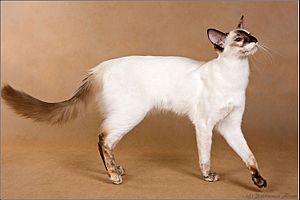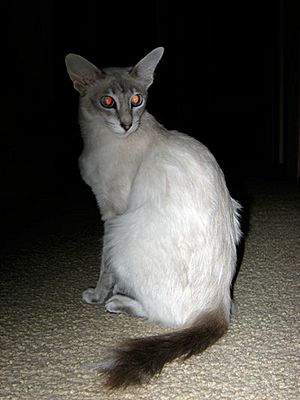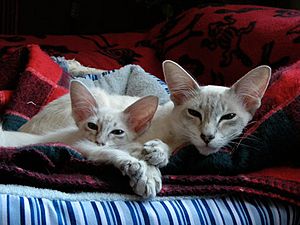Javanese cat facts for kids
Quick facts for kids Javanese |
|
|---|---|

A chocolate tortoiseshell point Javanese cat
|
|
| Other names |
|
| Origin | Canada, United States (foundation stock ultimately from Southeast Asia) |
| Breed standards | |
| CFA | standard |
| Domestic cat (Felis catus) | |
The Javanese cat is a beautiful purebred domestic cat. It is also known as the Colorpoint Longhair in some places. This cat is a special type of Balinese cat that was developed in North America. Javanese cats have medium-long fur and unique color patterns called "point coloration." This means their bodies are lighter, and their faces, ears, paws, and tails are darker. These patterns can include lynx (tabby) point, tortoiseshell point, or red/cream point. The name "Javanese" comes from the tradition of naming Oriental-style cats after places in Southeast Asia.
Different cat clubs and registries classify the Javanese cat in various ways. Some see it as its own breed. Others consider it a special Javanese division of the Balinese cat. In some cases, it might even be grouped with the Himalayan cat into a single breed called Colourpoint. This article mainly talks about the Javanese cat as defined by the Cat Fanciers' Association (CFA).
Contents
History of the Javanese Cat
The name Javanese cat was first used around 1950 by a breeder named Helen Smith. She used it for a different type of cat she was working on. It's not known if she ever visited Indonesia. The name was chosen because many Oriental cat breeds are named after countries and islands in Southeast Asia.
Around 1978, cat breeders in Canada and the United States wanted the Cat Fanciers' Association (CFA) to accept their "new colors" of Balinese cats. These were Balinese cats with different point colors than the traditional ones. In 1979, the CFA allowed these cats to be registered. However, they were accepted as a new breed, not just a part of the Balinese breed. The name "Javanese" was chosen by looking at a map and picking Java, an island close to Bali.
The Javanese cat gained "Provisional" status in the CFA in 1984. This meant it was on its way to becoming a recognized breed. By 1986, the CFA Javanese achieved full "Championship" status. This allowed them to compete in cat shows. In 2008, the Javanese was merged back into the Balinese breed. It became known as the Javanese Division of the Balinese. This change made the CFA's rules more similar to other cat registries.
How Javanese Cats Are Classified
In the Cat Fanciers' Association (CFA), the Javanese is now a sub-breed or division of the Balinese. It includes Balinese-ancestry cats with coat colors that are not the traditional ones. The traditional Balinese colors are seal, blue, chocolate, and lilac solid colorpoints. Any Balinese cat with lynx (tabby), tortoiseshell, or other point colorations is considered a Javanese in the CFA.
For many years, breeders could cross Javanese cats with Balinese, Siamese, and Colorpoint Shorthairs. This helped keep the Javanese cat's genes healthy and diverse. Now, under current CFA rules, only "certain limited outcrossing" is allowed. This needs special permission from the CFA. These cats can only be crossed with the Oriental Longhair. All outcrossing will stop at the end of 2025.
Some other cat registries call these non-traditional colored Balinese cats "Colorpoint Longhair." However, this name can be confusing because it refers to different breeds in some places. For example, in the World Cat Federation (WCF), cats that others call Javanese or Colorpoint Longhair are grouped with the Himalayan cat into one breed called Colourpoint. Most other registries consider the Himalayan cat a separate breed. It is a mix of Balinese and Persian cats, and it only has traditional Balinese/Siamese colors. To make things even more confusing, some registries use the name Javanese for what others call the Oriental Longhair, which does not have point coloration at all.
What Javanese Cats Look Like
The Javanese cat has a long, silky coat. It comes in many different colors and patterns. Unlike most long-haired cats, the Javanese has a single coat, not a double coat. This means its fur lies close to its body, making it look sleek and elegant.
Like the Colorpoint Shorthair, the Javanese has "point coloration." This means their body is pale, and their face, ears, paws, and tail are darker. But Javanese cats can have more coat colors and patterns than Balinese or Siamese cats. Their colors can range from dark brown to almost white. They can also be reddish, bluish, tabby, lynx point, cream point, or tortoiseshell (tortie). There are even unusual combinations like "blue-cream point" or "cinnamon-tortie lynx point." The CFA recognizes 24 different Javanese color combinations. All Javanese cats always have beautiful blue eyes.
Javanese Cat Behavior
Javanese cats are known for being very intelligent. They tend to be quite vocal, meaning they "talk" a lot, sometimes for no clear reason. This is a trait they share with their Siamese ancestors. They love to play, jump, and be close to people. They enjoy being involved in whatever their owners are doing. If they don't get enough attention or playtime from humans or other pets, they can become sad. They are also said to be good at hunting mice.
Health of Javanese Cats
Javanese cats can have some of the same common genetic disorders as Balinese and Siamese breeds. These can include dental problems, a condition called Amyloidosis, IBD (Inflammatory Bowel Disease), HCM (Hypertrophic Cardiomyopathy), and certain eye issues.
See also



